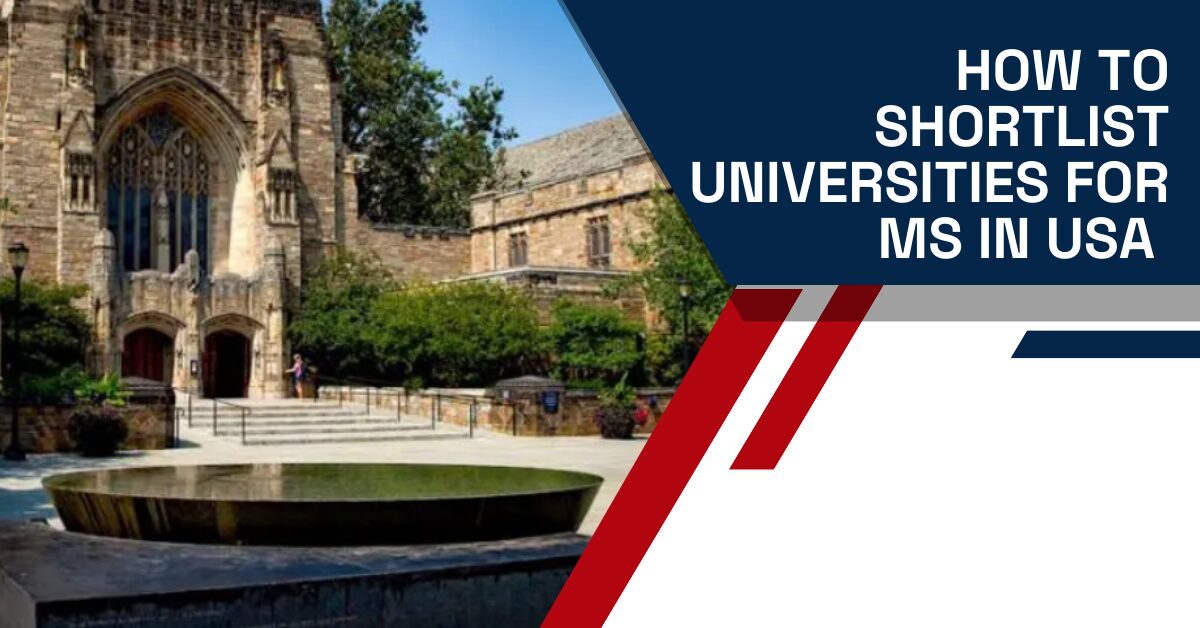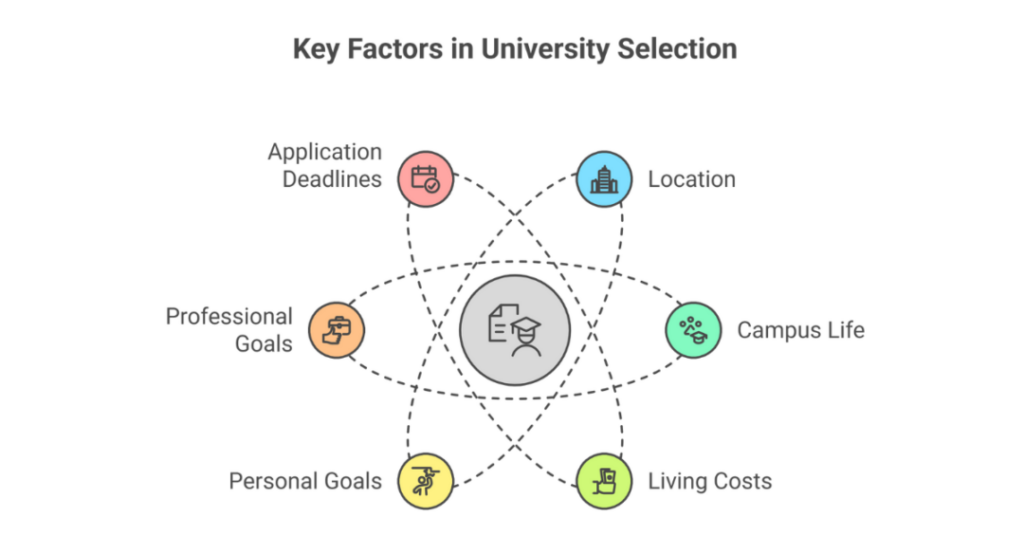23 June 2025
6 minutes read
How to Shortlist Universities for MS in the USA: A Guide for Indian Students

Key Takeaways:
- How to shortlist universities for MS in USA: Focus on factors like program specializations, tuition fees, and location to match your goals.
- Research top MS programs to identify universities that align with your profile and financial situation.
- Weigh the pros and cons of public vs. private universities, considering factors like costs, financial aid, and campus life.
Applying for MS in the USA can be overwhelming; there are over 500 universities offering MS programs, each with its own unique selection criteria. Many international students struggle to shortlist universities based on their profile, GRE score, IELTS/TOEFL score, and budget.
With deadlines looming and the pressure of tuition fees and living expenses, it’s easy to feel lost. To help you navigate this, we’ll guide you on how to shortlist universities for MS in the USA by focusing on factors that align with your academic goals, financial situation, and chances of acceptance.
Understanding Your Academic and Career Goals
When learning how to shortlist universities for MS in the USA, the first step is aligning your academic and career goals. Consider the field of study, whether you aim to pursue Masters in USA in a top university or one with specific strengths in your area. Your GRE and IELTS / TOEFL scores will heavily influence your chances of acceptance.
Assess the selection criteria, including university rankings, financial aid options, and tuition fees. This thoughtful process will help you narrow down the list of universities based on your profile and goals.
Researching Top MS Programs in the USA
Researching the top MS programs in the USA is a critical part of the process when planning to pursue MS in the USA. With many universities offering diverse courses, it’s essential to shortlist universities based on their rankings, application process, acceptance rates, and your own profile.
Factors such as the fall or spring intake, financial aid opportunities, and tuition fees also play a crucial role in the decision-making process. Below is a table of 10 top universities in the USA for MS, helping you get started on your journey:
| University Name | Location | Acceptance Rate | Fall Intake | Spring Intake | Average GRE Score | Tuition Fees (USD) | Scholarships Offered |
|---|---|---|---|---|---|---|---|
| Massachusetts Institute of Technology | Cambridge, MA | 7% | Yes | No | 330+ | 50,000+ | Yes |
| Stanford University | Stanford, CA | 5% | Yes | No | 325+ | 54,000+ | Yes |
| University of California, Berkeley | Berkeley, CA | 17% | Yes | Yes | 320+ | 45,000+ | Yes |
| Harvard University | Cambridge, MA | 5% | Yes | No | 330+ | 50,000+ | Yes |
| California Institute of Technology | Pasadena, CA | 6% | Yes | No | 320+ | 52,000+ | Yes |
| University of Illinois Urbana-Champaign | Urbana-Champaign, IL | 60% | Yes | Yes | 315+ | 30,000+ | Yes |
| University of Texas Austin | Austin, TX | 39% | Yes | Yes | 315+ | 40,000+ | Yes |
| University of Washington | Seattle, WA | 49% | Yes | Yes | 310+ | 39,000+ | Yes |
| University of Michigan | Ann Arbor, MI | 23% | Yes | Yes | 315+ | 45,000+ | Yes |
| University of California, San Diego | La Jolla, CA | 32% | Yes | Yes | 310+ | 40,000+ | Yes |
These universities offer robust MS programs, but shortlisting colleges for MS involves matching their selection criteria, GRE scores, application deadlines, and financial aid availability with your profile. Use this list of universities in the USA for MS as a starting point to evaluate your options.
Evaluating University Rankings and Reputation
When evaluating university rankings and reputation, consider the top universities for MS in the USA based on their academic performance, faculty, and resources. Your goal should be to shortlist universities that align with your MS course interests and career goals.
Focus on the reputation of US universities, their acceptance rates, and the chance of getting admitted based on your GRE score, IELTS score, and profile. Apply early to top universities for MS in the USA to ensure you meet application deadlines and maximize your opportunities.
Assessing Course Specializations and Faculty Expertise
When shortlisting universities for MS in the USA, assess the course specializations offered by each institution. Top universities in USA for MS provide a range of MS courses in various fields, from data science to engineering. Review faculty expertise, as their research interests and industry connections can significantly impact your education.
Consider US universities known for their strengths in your area of interest. Pursue MS in the USA by applying early, ensuring you meet all deadlines for fall intake and securing financial aid where possible.
Considering Location, Campus Life, and Living Costs
When shortlisting universities for MS in the USA, consider location, campus life, and living costs. Some universities for MS in the US are located in high-cost cities, which may impact your budget. Review universities in the USA for MS based on affordability, nearby job opportunities, and campus culture.

Research whether the university aligns with your dream universities for studying MS. Choosing the right university also involves balancing extracurricular activities and tuition fees, ensuring a fit with your personal and professional goals while considering application deadlines.
Exploring Scholarships and Financial Aid Options
When shortlisting universities for MS in the USA, exploring scholarships for international students and financial aid options is essential. Many top universities for MS offer financial support, which can significantly reduce your tuition burden. Research universities for pursuing MS with robust scholarships for international students.
Consider universities in the USA for MS that provide assistantships or fee waivers. Studying MS in the US requires careful planning of your budget and deadlines, ensuring you apply early to secure funding while shortlisting universities that fit your financial capacity.
Checking Admission Requirements for Indian Students
When shortlisting universities for MS in the USA, it’s crucial to check the admission requirements for Indian students. Each university for MS in USA has its own criteria, including GRE/TOEFL/IELTS scores, academic background, and sometimes interviews. Carefully review the application process and specific universities to ensure you meet deadlines and qualifications.
Studying MS in the US means understanding the universities you can apply to based on your profile. This helps shortlist universities for MS that align with your long-term career goals and improve your chance of getting admitted.
Weighing the Pros and Cons of Public vs. Private Universities
When shortlisting universities for MS in the USA, an important decision is choosing between public vs. private universities. Both types offer unique advantages, but they also come with their own set of challenges.
For international students, particularly those looking to study abroad and pursue MS in USA, understanding the differences is key. Below is a comparison of public universities vs. private universities to help you evaluate which aligns best with your academic goals and financial situation.
| Factor | Public Universities | Private Universities |
|---|---|---|
| Tuition Fees | Generally lower for in-state students | Higher, with fewer fee waivers or discounts |
| Financial Aid | Often offer government-sponsored scholarships | More private scholarships and assistantships |
| University Reputation | Many are top-ranked in specific fields (e.g., UC Berkeley) | Known for prestige and strong networks |
| Class Size | Larger class sizes, more competition | Smaller, more personalized attention |
| Research Opportunities | Ample research funding, especially in STEM | High research funding but often with specialized focus |
| Campus Life & Extracurriculars | Diverse student body, extensive clubs and activities | More focused extracurricular options, often elite clubs |
Weigh these factors carefully when deciding which universities for MS in the US to shortlist for MS based on your profile and goals.
How to Narrow Down Your List of Universities for MS in the USA?
Narrowing down your list of universities for MS in the USA can feel overwhelming, but it’s essential to focus on key factors that align with your academic and career goals.

With so many universities in the USA for MS, shortlisting universities based on your profile, budget, and program interests will make the process easier. Here’s how to effectively shortlist for MS in the USA:
- Identify your field of study: Choose MS courses that align with your career goals and interests.
- Consider university rankings: Focus on top universities for MS and evaluate their reputation in your field.
- Evaluate tuition fees and living costs: Compare universities for MS in US based on affordability for international students.
- Review admission requirements: Check GRE/TOEFL/IELTS scores, application deadlines, and eligibility criteria for universities you can apply.
- Look at campus life and extracurriculars: Choose a university for MS in USA that offers a vibrant student life and networking opportunities.
- Factor in location and job prospects: Ensure the universities for pursuing MS are located in areas with strong job markets in your field.
By keeping these points in mind, you’ll be better equipped to choose a university that fits your academic, personal, and professional goals.
Conclusion
Shortlisting universities for MS in the USA involves a careful balance of factors such as tuition fees, program specializations, location, and admission requirements. Whether you’re eyeing top universities for MS or looking for the right fit, it’s essential to consider your long-term goals and personal preferences.
Use a strategic approach to narrow down universities to shortlist based on your profile and aspirations. At Ambitio, we specialize in profile building and study abroad consultancy, guiding you every step of the way in your MS application process.
Join Ambitio Elite today to make your dream universities a reality and secure your future in the US! Get in touch with us!
FAQs
What is the ideal GRE/TOEFL/IELTS score for top universities in the USA?
While score requirements vary among universities and programs, aiming for a GRE score above 320 and a TOEFL/IELTS score above 100/7.0 is often recommended for competitive admissions. However, it’s essential to check each university’s specific requirements.
How many universities should I shortlist for my MS applications?
It’s advisable to shortlist a balanced mix of universities, including ‘reach,’ ‘match,’ and ‘safety’ schools. A common approach is to apply to around 8 to 12 universities. The exact number may vary based on your profile and application strategy.
When is the right time to start the application process for MS in the USA?
Starting the application process 6 to 12 months in advance is recommended. Research universities, prepare your application materials, and ensure you meet deadlines. Deadlines for fall and spring intakes can differ significantly, so plan accordingly.
How can I increase my chances of receiving financial aid or scholarships?
To enhance your chances of receiving financial aid or scholarships, apply to universities that offer such opportunities and meet their application deadlines. Additionally, maintain a strong academic record, craft a compelling Statement of Purpose (SOP), and seek out external scholarships.
Is it essential to visit universities in person before applying?
While visiting universities in person can provide valuable insights, it’s not always essential. Many applicants rely on virtual tours, online forums, and speaking with current students to gather information. In cases of international applicants, visiting may not always be feasible due to distance and costs.
Can I get fee waivers for MS applications?
Some universities offer application fee waivers based on financial need or other criteria. Always check with the admissions office about available options.
Is it worth applying to top-tier universities if my profile isn’t perfect?
Yes, if these are your dream schools. Top universities look at applications holistically, so strong parts of your profile might offset weaker areas.

You can study at top universities worldwide!
Get expert tips and tricks to get into top universities with a free expert session.
Book Your Free 30-Minute Session Now! Book a call now




























